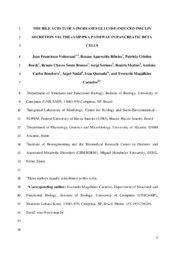Por favor, use este identificador para citar o enlazar este ítem:
https://hdl.handle.net/11000/3815Registro completo de metadatos
| Campo DC | Valor | Lengua/Idioma |
|---|---|---|
| dc.contributor.author | Vettorazzi, Jean Franciesco | - |
| dc.contributor.author | Ribeiro, Rosane Aparecida | - |
| dc.contributor.author | Borck, Patricia Cristine | - |
| dc.contributor.author | Souto Branco, Renato Chaves | - |
| dc.contributor.author | Soriano, Sergi | - |
| dc.contributor.author | Merino Antolín, Beatriz | - |
| dc.contributor.author | Boschero, Antonio Carlos | - |
| dc.contributor.author | Nadal Navajas, Ángel | - |
| dc.contributor.author | Quesada Moll, Iván | - |
| dc.contributor.author | Carneiro, Everardo M. | - |
| dc.contributor.other | Departamentos de la UMH::Biología Aplicada | es |
| dc.date.accessioned | 2017-09-08T15:23:27Z | - |
| dc.date.available | 2017-09-08T15:23:27Z | - |
| dc.date.created | 2016-03 | - |
| dc.date.issued | 2017-09-08 | - |
| dc.identifier.uri | http://hdl.handle.net/11000/3815 | - |
| dc.description.abstract | Objective While bile acids are important for the digestion process, they also act as signaling molecules in many tissues, including the endocrine pancreas, which expresses specific bile acid receptors that regulate several cell functions. In this study, we investigated the effects of the conjugated bile acid TUDCA on glucose-stimulated insulin secretion (GSIS) from pancreatic β-cells. Methods Pancreatic islets were isolated from 90-day-old male mice. Insulin secretion was measured by radioimmunoassay, protein phosphorylation by western blot, Ca2 + signals by fluorescence microscopy and ATP-dependent K+ (KATP) channels by electrophysiology. Results TUDCA dose-dependently increased GSIS in fresh islets at stimulatory glucose concentrations but remained without effect at low glucose levels. This effect was not associated with changes in glucose metabolism, Ca2 + signals or KATP channel activity; however, it was lost in the presence of a cAMP competitor or a PKA inhibitor. Additionally, PKA and CREB phosphorylation were observed after 1-hour incubation with TUDCA. The potentiation of GSIS was blunted by the Gα stimulatory, G protein subunit-specific inhibitor NF449 and mimicked by the specific TGR5 agonist INT-777, pointing to the involvement of the bile acid G protein-coupled receptor TGR5. Conclusion Our data indicate that TUDCA potentiates GSIS through the cAMP/PKA pathway. | es |
| dc.description.sponsorship | This work was by grants from the Spanish Ministerio de Ciencia e Innovación (BFU2013-42789-P; BFU2011-28358) | - |
| dc.description.sponsorship | This work was supported by grants from Fundacão de Amparo á Pesquisa do Estado de São Paulo (FAPESP 2013/01318-4) | - |
| dc.description.sponsorship | This work was supported by grants from Conselho Nacional para o Desenvolvimento Científico e Tecnológico (CNPq 200030/2014-0) | - |
| dc.format | application/pdf | es |
| dc.format.extent | 36 | es |
| dc.language.iso | eng | es |
| dc.rights | info:eu-repo/semantics/openAccess | es |
| dc.subject | β-cell | es |
| dc.subject | Bile acids | es |
| dc.subject | Insulin secretion | es |
| dc.subject | TUDCA | es |
| dc.subject.other | 577 - Bioquímica. Biología molecular. Biofísica | es |
| dc.title | The bile acid TUDCA increases glucose-induced insulin secretion via the cAMP/PKA pathway in pancreatic beta cells | es |
| dc.type | info:eu-repo/semantics/article | es |
| dc.identifier.doi | 10.1016/j.metabol.2015.10.021 | - |
| dc.relation.publisherversion | https://doi.org/10.1016/j.metabol.2015.10.021 | - |

Ver/Abrir:
2016 Metabolism Vettorazzi.pdf
561,01 kB
Adobe PDF
Compartir:
 La licencia se describe como: Atribución-NonComercial-NoDerivada 4.0 Internacional.
La licencia se describe como: Atribución-NonComercial-NoDerivada 4.0 Internacional.
.png)